Monrovia vs Lowes
So I'm at Lowes today, I'm looking for a Japonica. I see a Lowes sign that says "Japonica" for eight dollars and change and I snap up one of these beautiful plants. I'm not even sure if what I bought was a Japonica...I'll get back to that.
The plant tag is a 'Lowes" tag with a color photo of the plant. The latin name is Ternstroemia gymnanthera "Bronze Beauty", it is trademarked as a Cleyera Bronze Beauty and has a patent pending.
Later when I'm home and I google the latin name, one of the first results that shows up is the catalog entry on Monrovia. On the Monrovia site, the photo used for the plant is the EXACT same photo as on the Lowes tag...in fact, ALL of the info is EXACTLY the same.
So this has me wondering, did I buy Monrovia quality at a Lowes price, or when I buy Monrovia, am I getting Lowes quality? Any ideas about this?
I love the plant and have the perfect spot for it. I'm still not sure if I bought a type of Japonica or something called a "Cleyera"? It's a beauty either way!
Comments (37)
zamiagarden
Original Author17 years agoWait...so who gave birth? Ms. Monrovia or Ms. Lowes?
(Oh, and I think I did indeed buy a Japonica after all)
Related Professionals
West Milford Landscape Architects & Landscape Designers · Brunswick Landscape Contractors · Corona Landscape Contractors · Deerfield Landscape Contractors · Dickinson Landscape Contractors · Lady Lake Landscape Contractors · Paramus Landscape Contractors · South Farmingdale Landscape Contractors · South Lake Tahoe Landscape Contractors · Washington Landscape Contractors · Garden City Decks, Patios & Outdoor Enclosures · Philadelphia Decks, Patios & Outdoor Enclosures · Port Saint Lucie Decks, Patios & Outdoor Enclosures · Roanoke Decks, Patios & Outdoor Enclosures · Finneytown Stone, Pavers & Concretebahia
17 years agoLowes would be buying their plants from Monrovia. I wonder what plant you mean when you say "Japonica", because this is not a common plant name, but usually is a species name for plants coming from Japan. Also, Ternstroemia gymnanthera is not the same plant as Cleyera. So your whole post leaves me abit confused as to what you actually were looking for, and which one you bought.
zamiagarden
Original Author17 years agoSorry to confuse! But what I posted is exactly how the Lowes tag reads:
Cleyera Bronze Beauty TM PPAF
Ternstroemia gymnanthera 'Bronze Beauty' TMSo Lowes/Monrovia is calling it both Cleyera and Ternstroemia gymnanthera on the same tag (Lowes is saying they ARE the same plant).
The "Japonica" comes in because 1) I was browsing for a Japonica after it had been recommended to me through a different post and then 2) I saw a display sign saying "Japonica $8.00" which led me to this plant.
Nowhere on the Lowes tag does it say "Japonica" but I've been searching on the internet tonite and it seemed, to me, that what I bought could be a Cleyera Japonica...if there is such a thing? There is in cyberspace!
So, yeah, not too sure what I bought, but it looks "japonica-like" and it will work for my zone, site, soil, etc.
Thanks for letting me know Monrovia is the source Bahia, and I'd like to hear any further thought you have on this plant.
laag
17 years agoIt is true that Monrovia Nursery is the source. A source that has a very active marketing strategy that has "planted" their name into the public and have tried to make it synonomous with quality and being the best stuff out there. They have succeeded in their strategy by having you very excited that you got a plant from what you perceive, it isassumed, to be an elite source, but at a bargain center. Where did you get that info from? Commercials designed to get you to think (maybe think is the wrong word - follow) that way.
You have no idea that what you bought is actually the plant that was recommended to you.
Maybe it was Pieris japonica, Spiraea japonica, Lonicera japonica, Camelia japonica, Eriobotrya japonica, Chaenomeles japonica, Cryptomeria japonica, Skimmia japonica, Stephania japonica, Torilis japonica, Aucuba japonica, .... that was recommended. (from a friend or tv show?)
So in the end, are you very happy about your purchase because you think it is a bargain priced plant from a reputable source even though you have no idea if it is the plant that was recommended and your source for understanding what is a good nursery is their advertising and sponsoring of tv shows?
Here is a link that might be useful: Article on relationship
Nell Jean
17 years agoMonrovia name is now on a large wholesale nursery in the next county. Same plants, new label.
Name recognition is harder and harder with so many 'new' companies to remember. I was telling someone about the agapanthus I bought in gallon 'Wachovia' pots. The next day I corrected my typing. The bank isn't selling plants, YET.
Monrovia's label on the agapanthus was printed with $8.95. They were 'on sale' at a private nursery for $6.95, generic bulbs, nice marketing ploy.
view_west
17 years agoGotta chime in here, Monrovia has a history of very bad phytosanitary practices. They sent out shipments from a nursery they KNEW had the infectious microbe Phytophthora ramorum (first known as Sudden Oak Death SOD - but it kills a broad range of plants oaks, ferns, roses, camelias...)
In March of this year [2004], during a routine inspection, SOD was discovered on Camellia cultivars at the Azusa, California, nursery of Monrovia, one of the nation's largest plant wholesalers. The names of these cultivars have yet to be released, but it's known that many of them were shipped around the countryÂMonrovia supplies around 5,000 garden centers nationwide.
I avoid Monrovia plants like the plague- and I mean that literally!
-VW
Here is a link that might be useful: Monrovia & Nursery Nightmare from Brooklyn Botanic Garden
zamiagarden
Original Author17 years agoWow laag.....harsh.
Lowes, being a big box discount store, would carry what I would presume to be only average quality plants...until I posted this question I had no idea where their plants came from (I assumed they bought them wholesale, but I did not know who the supplier might be).
Being a relatively new gardener, I did notice the slick Monrovia ads in the magazines (Garden Design, Fine Gardening, etc.). Considering the cost of those ads, I assumed Monrovia to be a sucessful company (somebody is buying their plants) and that their plant quality must be north of "crap", and yes, probably north of "Lowes".
From a business standpoint, I thought it interesting that Monrovia might be in a private label deal with Lowes...so I posted the question. As for being excited at the prospect, well why not? The quality of Lowes plants might be a bit higher than I originally thought it was and that's where I usually end up buying my plants. Sorry, but I'm on a budget (and I like their guarantee).
As for having 'no idea that I actually bought the plant that was recommended to me', that is not accurate. When I picked up the plant, I believed it to be a japonica, but since this was the first time I've ever looked at a japonica in person (again - new gardener!), I wasn't certain. I read the plant tag, and it fit the needs I had, so I bought it with the intention of researching it more when I got home.
The japonica was recommended by a very nice member of this forum right here.
You know laag, I may be new to gardening, but I didn't just fall to the earth yesterday. How about cutting the new gardeners some slack and cut the attitude? Why not be constructive?
zamiagarden
Original Author17 years agofoxesearth,
That's funny! Who knows, with all the subprime lending issues going on, Wachovia might need to diversify and could end up selling plants one day! Maybe money trees?view west,
Wow - thanks for that link. I've heard of Sudden Oak Death - oaks are very prevalent here (NE FL - lots of Live Oaks). But how do you avoid the Monrovia plants if they are doing private label? How do you know the source? Where do you buy your plants, by the way, do you prefer local nurseries over the Lowes/Home Depot types?
Brent_In_NoVA
17 years agoI also think it is funny that you are excited because you think you got a plant grown by Monrovia. I guess their marketing machine is working! I would be more excited if I knew that the plant came from a local grower in my area than a huge corporation, but I guess that is just me. BTW, I have been pretty happy with the quality or plants at my local Lowes. The local Home Depots are a different story but it seems that this varies from store to store. I purchase the majority of my plants at a local nursery that has 20 or so outlets.
About the japonica name...The name japonica by itself does not indicate a specific plant. It basically means "from Japan" and can be applied to thousands of plants. For example the plant Spiraea japonica is a type of Spiraea that originated in Japan.
In any case it looks like you have a Ternstroemia gymnanthera...which does have the common name Japanese ternstroemia...so it might also be from Japan. The NCU page on it says that it is often sold as Cleyera japonica. Yea, I could see how anybody could be confused on this one!
- Brent
Saypoint zone 6 CT
17 years agoThe common name "Japonica" is sometimes used to describe Flowering Quince, but if someone told me they wanted "Japonica", I would have no idea what plant they were referring to.
I did not think laag was harsh, he was just stating some facts, and correctly.
view_west
17 years agoHoo boy! Now I get a chance to be political *grin*.
But how do you avoid the Monrovia plants if they are doing private label? How do you know the source?
Those are really good questions Zamia G. !
There are several factors to consider:
-- Plants and soil might bring in pathogens (fungal, prokaryotic, or protists like Phytophthora spp.) This was my main concern with Monrovia.
-- Plants that are not native might escape easily and be nuisances in native ecosystems. [Here in Wisconsin PLEASE do not plant Buckthorn, or Reed Canary Grass, or Purple Loosestrife.] Sales are often unrestricted, so buyer beware.
-- Plants that are not of the local ECOTYPE. Opinions differ here, and how important it is that you have South Central Wisconsin Bouteloua curtipendula and not South Western Wisconsin Bouteloua curtipendula.
-- Plants that might be poached from wild areas where they are endangered. Orchids, cactuses and - yes - even some cycads! (I'm sure your Zamia is legit).
-- Supporting your local economy and growers.
MHO follows:
1) dividing from neighbors is the best way to get plants. The price is right, and you know if the plants are robust enough to need dividing in your locality they will probably do well in your garden.2) buying locally would be next best. The question here, though, is how long has that plant been raised 'locally' ? It might be a cutting from an orchard that has been on a farm for a hundred years, or a a seed started from a local source, or a seed bought internationally. Or it could be from starter plants bought from a wholesaler, at various stages. At the other end of the spectrum is a truckload of plants shipped up from the equator, along with a few bugs and other beasties. YMMV.
2.5) mixed in here is buying seed that you buy from sources close or far away from you. There are not so many seed-borne pathogens, but there could still be invasive plants.
My own choices have been changing over the past few years. I have a gardening pal who shares all kinds of plants with me: Wild Ginger, Peonies, Clematis, Roses, Sweet Woodruff, and a rainbow of Daylily cultivars. I do admit a weakness for Holland-grown bulbs. I rationalize this by hoping the Dutch phytosanitary regulations are up to the best standards.
On top of this is a further argument that a person should grow ONLY NATIVES, which would be fun in Florida, but heck, a person can only stand so much Purple Coneflower and Little Bluestem here on the prairie *grin*.
In my perfect world, plants would be labeled with Country/State of Origin, and we could each make informed choices.
-VW
Here is a link that might be useful: Wisconsin's worst invasive plants
deeje
17 years agozamiagarden, I'm C&P-ing something Brent said in a post above. It's likely the most important part of the message that laag gave you, and I'm afraid you might've missed it completely:
"The name japonica by itself does not indicate a specific plant. It basically means "from Japan" and can be applied to thousands of plants. For example the plant Spiraea japonica is a type of Spiraea that originated in Japan."
(I added the bold)
deeje
17 years agoOops, posted that too soon. bahia said the same thing right off the bat, but Brent's wording might make it just a little more clear to you.
view_west
17 years agoOk, the harsh criticism here is running inaccurate.
In terms of scientific names japonica is a frequently used species designation, but a scientific name requires a Genus and a species name. Hence Spirea japonica or Fatsia japonica. The species name japonica all alone means nothing.
This differs from the use of ' Japonica' as a common name, as Saypoint mentioned.
ZG was very clear about the plant label:
Cleyera Bronze Beauty TM PPAF
Ternstroemia gymnanthera 'Bronze Beauty' TMAccording to Lowes, fwiw, the common name is Cleyera Bronze Beauty, the Genus is Ternstroemia the species is gymnanthera the cultivar (cultivated variety) is 'Bronze Beauty'.
-VW
Here is a link that might be useful: Bronze Beauty photo
gardengal48 (PNW Z8/9)
17 years agoI think we're making a bit of a mountain over a molehill. The "japonica" issue aside (and that has been explained very well), Ternstroemia gymnanthera IS the correct botanical name for Clereya japonica (older and no longer accepted). And Monrovia does sell to Lowe's but not under their very obvious, green labeled containers. They also sell a lesser grade product than they do to premium retailers.
And since the discovery of the SOD problem several growing seasons ago, all Monrovia product is USDA certified. There is no more fear of buying diseased product from them than there is buying it from any other wholesale grower. The SOD issue was far more a problem for Monrovia that it was for any recipients of their product as this pernicious disease is extremely common on the west coast and has a huge number of host plants that can be carriers as well as susceptible species. And since Monrovia's primary growing fields are located in California (the primary location of this disease), they were extremely hard hit.
As to buying locally, that's great in theory but many retail nurseries purchase plants from growers located all over the country (and even in Canada), so how exactly is the consumer to know what is local in origin and what is not? And many very popular and widely used landscape plants are proprietary to certain large wholesalers (Monrovia and Hines Horticulture being the two largest) and to exclude all plants from these sources is to unnecessarily limit one's selection.
zamia, the use of "japonica" to refer to a specific plant is more common than you might think and I'd not feel overly embarrassed if I were you :-) I know some rather experienced gardeners that are not on the cutting edge of botanical terminology that use it to this day to refer to one of several possiblities. Even better are the folks that call or come into the nursery asking questions about their "monrovia" plant, assuming the labeling on the container is what was growing inside of it!
bahia
17 years agoI might just add that Ternstroemia gymnanthera is not commonly called Japonica here in California, but regardless of what you choose to call it, it is a lovely shrub with glossy evergreen foliage and fresh leaves are pleasantly bronze tinted. The shrub is a great plant for shady spots and looks good all year round, even though it doesn't have showy flowers. And at least in our local climate, it is rather slow to grow, so it isn't likely to quickly outgrow its space, although the growth rate may be vastly different under hot humid Florida conditions. Call your plant a Ternstroemia,(rather than a Japonica), and everyone will know what you are talking about.
laag
17 years agoI can be harsh, but the post seems to be either a proclaimation that Monrovia has become the box store of nurseries, or that Lowes carries high end products.
I know little about either Lowes or recent products from Monrovia, so I'm not sure.
The state flower of Idaho is Syringa ...lilac? No, mock-orange (Philadelphus lewisii). Go figure.
zamiagarden
Original Author17 years agoLaag,
I've read some of your other posts and learned a lot from them, and your initial replies to my question were no exception in that regard, but when you responded to mine, there was, as I interpreted it, a certain tone to it that I hadn't seen in your other posts. As if I were to have no selective abilities and was completely under the control of the marketing machine.
I've noticed some threads with some "newbie" bashing that probably had me a little oversensitive to the manners of speaking via forum. I should have just let it go...and so I shall. No harm done, hope you feel the same.
Everyone,
So, as I understand it, I should refer to this plant as a Ternstroemia, which is how it was labelled on the tag, and never utter the word "Japonica" again...ha! It is indeed the same plant as the picture in the link view west provided.
As for my question of quality, I guess the quality of Monrovia is debatable. I see now how huge of a nursery they are, and by them selling private label at different price points/quality levels, it puts the consumer back in the position of placing the importance of finding a quality reseller over seeking the product itself (not that I was seeking Monrovia in the first place...really I wasn't!).
I'd love to buy local, and I really haven't pursued it enough. The few times I went into my local nurseries, they didn't have everything I was looking for, though they did offer to order what I needed, but I didn't want to commit to buying a plant sight unseen. In addition, their policies were ambiguous if the plant did not survive transplant. It's all still a little imtimidating to go and purchase with gusto (though I have to say, my survival rate is quite high).
I don't know too many gardeners, and the ones I know have different gardening objectives than I do. We also have different taste in plants, so I haven't been able to tap them for nursery recommendations, etc.
**If anyone has a local nursery they love in Jax, FL, please post it (I'm on the Southside)**
View West, I love your list! I just started dividing my own plants, haven't grown anything from seed yet, and yes, I think it is easier to go native in Florida.
Thank you so much everyone for taking the time to post (I'm including you too here laag!)!.
bahia
17 years agoAccording to Sunset Western Garden Book, Cleyera japonica is related to Ternstroemia gymnanthera, but is not the same plant. Ternstroemia is a much smaller growing plant, as Cleyera can reach 15 feet tall by across, and has fragrant flowers, (as does Ternstroemia).
I don't think the Monrovia label makes much difference one way or the other as to quality, but they do have alot more marketing muscle than other wholesale growers, and also have this rather annoying habit of creating nonsensical pet names for their new cultivar introductions. As Monrovia doesn't sell directly to the public, they have little to do with the retail prices at nurseries.
zamiagarden
Original Author17 years agoThat makes sense - the tag on this one says it will grow 8-10' tall and 4-6' wide and will have fragrant white flowers appear in Spring.
Yeah, I'm not going to worry too much about the labels. I'll continue to buy from Lowes for now and start to poke around the local nurseries some more.
Thanks Bahia!
laag
17 years agoZamia,
No need to apologise, I can be abbrassive at times and that was one of those times. I'm consistantly nicer in real life, or so I think. You are obviously a nice person.
bindersbee
17 years agoEven the big box stores can get in some good plants at times. I picked up 3 'Endless Summer' Hydrangeas at Home Depot yesterday and yes- I am very excited about it. Particularly since my local high-quality nursery can't keep them in stock even at a higher price than I paid at Home Depot.
I'm confused about what plant you bought too since I've never heard the name 'japonica' used as a common name to refer to any plant but hey, if you've since researched and gotten more information based on the botanical name on the tag, you should be good to go.
DYH
17 years agoAs a licensed nursery retailer, I thought I'd chime in here on how the business works with patented plants and also the cleyera discussion. Also, I can give a bit of info on agricultural inspections.
Wholesale nurseries (like Monrovia and local ones) can enter a contract with the breeder (patent owner) of a plant and thereby propagate it and sell it.
Multiple wholesale nurseries are therefore licensed to propagate and sell the same plant. Finding a plant on Monrovia's site doesn't necessarily mean they have exlusive rights to the patent nor that they are the breeders nor that they are the nursery who supplied the plant to Lowe's.
Wholesale nurseries, for a fee, will label potted plants with the retail store's name, use the retail's skew number, etc. so that the plants are delivered "retail ready". Or, the retail store can print the labels and send them to the wholesale nursery to use.
Photos of patented plants are usually the same photo, no matter what retailer is printed on the label or what wholesale nursery propogated the patented plant.
(BTW, any plant with a patent or patent pending, is not supposed to be propagated, exchanged or sold without paying the patent owner.)
As for cleyera, the nursery that I purchase from has "cleyera japonica" listed separately from ternstromia. There are many patented varieties of ternstromia.
Every nursery wholesaler and retailer (who is legally licensed) is subject to random annual inspections by their state's dept of agriculture. Plants that are shipped out-of-state must also be randomly inspected by the Feds. In quarantine areas (such as fire ants), the nursery can ship plants provided they have followed the rules to eradicate the pest with approved methods. Unfortunately, random inspections won't catch every pest or disease.
Hope this is helpful in understanding the wholesale/retail relationship.
view_west
17 years agoReally interesting info, WonByHerWIts! Thank you for providing a retailer's persepective.
Unfortunately, random inspections won't catch every pest or disease.
This is what steers me away from Monrovia plants. At this point it is not possible to identify every single microbe that might be lurking in a single gallon pot of soil without a slew of postdocs, and. maybe, a quarter of a million USD in lab time and supplies (don't ask me how I know this *grin/2*).
(BTW, any plant with a patent or patent pending, is not supposed to be propagated, exchanged or sold without paying the patent owner.)
Any idea what the federal penalties are on this? I, er, have this friend, who wants to know.
Hope your garden grows well, Zamiagarden!
-VW
gardengal48 (PNW Z8/9)
17 years agoAlso from a retailer's perspective (and one that is responsible for buying the plants sold at a retail nursery), not all patented plants are available for a wide distribution. For example, Monrovia has developed and patented a number of plants that are ONLY available through them and under their label. That way, they very nicely control pricing and distribution. I only know of one other mega-wholesaler that operates the same way but there could very well be a few more.
As to the random inspections, yes that is done for any wholesaler and also most retailers as well. However, that is quite different from a USDA certification process, which is not the slightest bit random (inspections are performed regularly and routinely) but which IS focused on specifc pathogens and insect problems (i.e., the situation with SOD). As a certified wholesale nursery, Monrovia has been deemed SOD pathogen-free.
zamiagarden
Original Author17 years agoWonbyherwits,
Thanks so much for the insider's view...really interesting stuff.
I'm adding a scan of the tag here, this might have been more helpful in the beginning, but I just learned how to do it!
p.s. I'm going back for two more Ternstroemias tomorrow...tee hee!
{{gwi:27250}}
{{gwi:27251}}
Embothrium
17 years agoLooks like a ternstroemia. Plants sent out by the Horticultural Craftsmen over the years have often been badly potbound so it wouldn't matter if it was infested or not, as far as plant quality and performance (except with herbaceous plants that don't have woody roots) is concerned. A tree, shrub or climber that has been left in a band or liner to the point of becoming severely deformed, then grown on and sold will always be crap.
The amount of stock (from various sources) encountered in nurseries today that is j-rooted, kinked or potbound should be a scandal. What would happen if a high proportion of cars sold had engines that were destined to freeze up in a few years?
Saypoint zone 6 CT
17 years agoI happened to be in my local Walmart today, and stopped into the garden center to see what they were up to. They had a fair number of shrubs, including Azaleas, Rhodies, Globe Arborvitae, Emerald Green Arb., and assorted Junipers, all from a family owned nursery about 12 miles down the road. I didn't know they dealt with relatively small nurseries.
jakkom
17 years agoSOD is not just a problem with Monrovia, who seems to be tarred by the "if it's successful, let's kill it" school of thought that some folks have (and no, I'm not casting stones, that's just an observation from someone who's lived near Berkeley CA for some forty-odd years, LOL!).
They were the largest wholesale nursery affected, but certainly not the only one.
From the CA state SOD website:
"Synopsis:
Sudden Oak Death is a recently recognized disease that is killing oaks and other plant species in the western U.S. First noticed in 1995, the disease has been confirmed in the coastal areas north and south of San Francisco, and in a relatively remote location in southwestern Oregon. The pathogen responsible for the disease, a fungus-like organism called Phytophthora ramorum, is also found in Germany and Denmark, where it is causing a recently identified disease on Rhododendron and Viburnum.The pathogen was also discovered in European nurseries in the mid 1990s, and it has since spread to wildland trees in the U.K. and the Netherlands. Although the first P. ramorum-infested California nursery stock was identified in 2001 (Santa Cruz County), the U.S. nursery industry was not widely impacted by the disease until 2003, when the pathogen was detected in California, Oregon, Washington, and British Columbia nurseries."
roserx
16 years agoSince we're on the subject of Cleyera. What are your opinions of these 3 varieties, Bigfoot vs Bronze Beauty vs Leann? I want to use Cleyera as a windbreak hedge, so I am not opposed to pruning it in order to maintain its shape.
Saypoint zone 6 CT
16 years agoYou might want to start a new thread for a new topic. Probably a better question for the shrubs forum.
roserx
16 years agoI did, but I have never had much success in eliciting a response from the shrub site in the past.
mjsee
16 years agoI work at a Garden Center in NC. Here, when people come in looking for "a japonica" they are ALWAYS looking for one of the Pieris japonica cultivars. Always. Usually either 'Compacta' or 'Temple Bells.'
Cleyera is a great shrub here in NC...don't know how it will perform in SoCal. It grows pretty slowly here.
The local Lowes buys from some of the same nurseries as "my" GC...though most of our shrubs and perennials are from relatively local growers. My main complaint about Lowes is that they stock stuff that will NOT be happy in zone 7b NC. Last summer I helped a woman re-work an entire flower bed...she'd built it around a collection of Pacific Giant Delphiniums. Unless one is extremely lucky with one's micro climates PGD's melt out in July here. My GC won't sell them as perennial--we sell them as a pricey annual. Sure enough--she'd gotten them at Lowes.
The local Lowes plant care is below par, as well...but if you get there the day the stuff comes off the truck you CAN get a good deal.
melanie
steve_opteracreative_com
15 years agoFrom a marketing standpoint, The Bronze Beauty is patented by a small company in Alabama called PDSI, for more information please check plantdevelopment.com.
This particular plant was licensed out to Monrovia to sell, they did not come up with this particular cleyera.
Additionally, the plant will soon be marketed in your local lowe's as a Southern Living Plant Collection plant.
[quote]Since we're on the subject of Cleyera. What are your opinions of these 3 varieties, Bigfoot vs Bronze Beauty vs Leann? I want to use Cleyera as a windbreak hedge, so I am not opposed to pruning it in order to maintain its shape.[quote]
As for roserx's question, the three plants have their differences, the most prevalent is their height. Bigfoot: 15'-20', LeAnn: 10'-12', and Bronze Beauty: 8'-10'. All are accepting of pruning, and they all make a great hedge. Make sure to plant for the mature width to keep a consistent hedge.
That's my back of the tag talk for today.
lpinkmountain
15 years agoThis has been a fascinating post for me as a biologist. I have so much trouble buying plants because I want to just go by Genus species name, but I can hardly ever find a good label that has that on it. Also lots of confusion with the way the cultivars are named. It drives me nuts and I can see how it would drive a casual gardener even more nuts.
There's a lot of variables to buying good plants. How and where they were grown, were they shipped, how, where, what's the soil been like for them, how were they transplanted, how were they cared for, how were they bred. You can run into trouble in any number of areas--or not. For example, right now I have some type of horrible wilt that I think came into my garden last year from tomato plants I got at Home Depot. Meanwhile, I have a japanese maple I got MAIL ORDER from a reputable nursery recommended to me on GW japanes maple forum, it came in a cardboard box, looked like a stick version of Charlie Brown's Christmas tree, I planted it late over Thanksgiving weekend during an extended fall season that year, but had zero expectations for it. And yet is is growing like gangbusters, which I attribute to good breeding!!
On the other hand, I have bought scraggly looking somewhat pot bound (not to the extreme) versions of what I know to be hardy plants at K-Mart and they are doing fine. You have to know what you are doing--what is hardy, what is not, what is a good price and what is not. I once bought a whole flat of scraggly looking basil and a closeout sale at a nursery for 3.50, I figured if any of them lived it would be fine. Almost all did, since they were small and basil is an hardy annual that can recover. On the other hand, some of my local nurseries get their shrubs all hopped up on fertilizer and when you buy them and install them they soon poop out--a lot of nitrogen means lush leaf growth but weak overall structure. And sometimes all it takes is one stoned high school summer assistant to totally screw up a local nursery if they're not careful. Still, IMHO, if you can find a local nursery where they really love plants and take pride in what they do, you will not be sorry. Somehow, Monrovia just does not cut the mustard with me, marketing hype rarely means real quality, because producers of real quality do not need to advertise, they get their business by word of mouth. As for the big boxes, I have gotten some good deals there, but I am getting kinda wary, espcially after my wilt experience with HD. Pots of tomatoe seedlings seemed like a no brainer at the time. I have no absolute proof they vectored the wilt, they are just the most likely suspects since they all had it last year and the wilt spread to that area of the garden.
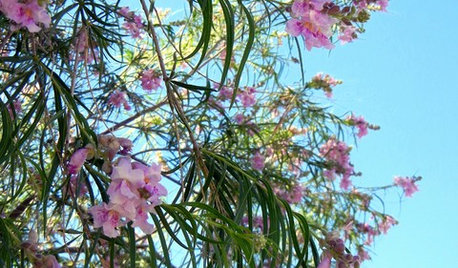
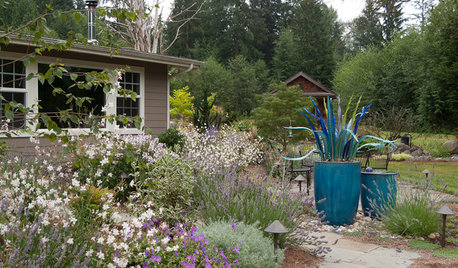
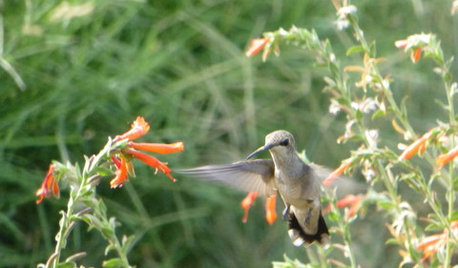



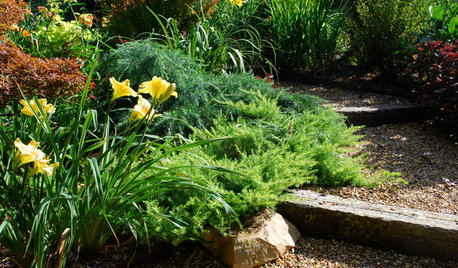

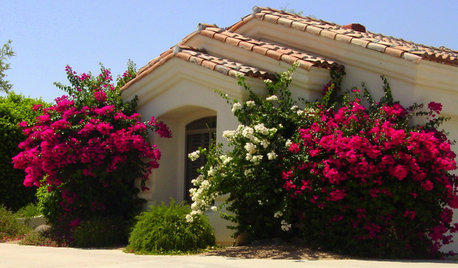







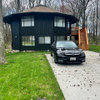

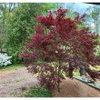

laag